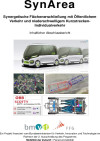SynArea – Synergetic area coverage by public transport and low-threshold short trip-private transport
Short Description
Starting point / motivation
Whereas in core cities the use of the private automobile is already stagnating or declining, the car remains in a dominating position in rural areas.
This is caused by a downward spiral of declining usage and service reductions in rural public transport. In the end, public transport is in many regions suitable only for school-transport and for certain groups of commuters. Also business models of innovative intermodal solutions like one-way-car-sharing are based on high density of demand and are therefore offered only in urban areas.
Thus, the insufficient coverage of rural areas by public and intermodal transport is getting progressively a critical factor for a more extensive modal shift towards more sustainable transportation. Another unsolved problem is the lack of mobility opportunities of people without the possibility of car usage.
Contents and goals
The primary aim of the project is to offer a range ofintermodal services for rural and suburban regions, which is attractive for persons with multiple accesses to mobility and, at the same time, improves the mobility opportunities for so far disadvantaged people.
Furthermore, it shall not negatively affect transportation safety, but be ecologically sustainable and economically feasible without significant increasing of public spending in the transport sector. This should be achieved by an optimisation of public transport in terms of lower network density, more frequent services and better interconnections. At the same time, accessibility of the stations is to be ensured by a new type of vehicles for individual transport.
The proposed solution, which shall be examined during the project in terms of technical and economic feasibility, is based on a new vehicle type for individual road transport, which is designed for a range of 5-15 km and synergetical use for wide target groups, and a reorganisation of the conventional, scheduled public transport: With a lower density of lines and stops, there can be provided shorter intervals and riding times as well as better interconnections.
Methods
The applied methods within the project include mainly the conception of individual vehicles and mobility services (schedules of public transport and networks of vehicle rental stations). Furthermore, the forecast of the usage of modes and networks as well as the calculation of costs and revenues were intended.
Results and Conclusions
Within the scope of the project, a new type of transport service was developed for two exemplary regions, consisting of redesigned scheduled public transport, an unconventional vehicle rental system and a demand-driven transport offer. The study also involved the design of technical components of the rental vehicles and stations as part of the offer.
The analysis of feasibility and impacts in the case of realization gave the following results concerning the project-achievement:
- The accessibility conditions for people without their own cars and / or without a weak driving ability are significantly improved
- The emissions of greenhouse gases and airborne pollutants are significantly reduced in Middle Burgenland, whereas the effect in the northern Viennese basin is small
- Regarding accident occurrence and the consequently induced accident costs in Middle Burgenland a very slight improvement could be calculated by means of optimistic assumptions. Conversely, deterioration is expected by using pessimistic assumptions. In the northern Vienna basin, there would be a minor deterioration in each calculation scenario.
- In both sample regions, the financing potential exceeds the costs and the concept. Therefore the financial feasibility would be possible without additional government spending.
- The variant with full coupling capability is economically and ecologically more efficient. The hence additional technical effort compared to the variant with restricted coupling capability is lessened by lower vehicle requirements and more efficient traffic.
Publications
SynArea – Synergetic area coverage by public transport and low-threshold short trip-private transport

The aim of the project is the coverage of rural and/or suburban regions with multimodal services, which are more attractive for customers and economically more efficient than conventional public transport, accessed by foot, bike&ride or park&ride, and at the same time ecologically and socially more sustainable, than the sole use of motorised individual transport.
Harald Buschbacher, Gerald Kelz, Edith Hartmann, Stefan Kirschbichler, Christian Obermayer
Publisher: BMVIT
German, 232 Seiten
Publication Downloads
Project Partners
Project management
Dr. Harald Buschbacher - ÖBB Personenverkehr Aktiengesellschaft
Project partners
- DI. Christian Obermayer - komobile w7 GmbH
- Dr. Jürgen Gugler - Technische Universit֤ät Graz - Institut für Fahrzeugsicherheit
- Mag. Barbara Hofleitner - Spirit Design - Innovation and Brand GmbH
- DI DI Dr.techn. Gerald Kelz - AMSD Advanced Mechatronic System Development KG
Contact Address
ÖBB Personenverkehr Aktiengesellschaft
Dr. Harald Buschbacher
Tel.: +43 (664) 617 97 25
E-mail: harald.buschbacher@pv.oebb.at
